After a successful uncrewed test flight to the International Space Station, Boeing's Starliner has returned to Earth.
The current test, according to Axios, paves the path for SpaceX to ferry NASA personnel to the space station in the future.

WHITE SANDS MISSILE RANGE, NM - MAY 25: In this handout provided by the National Aeronautics and Space Administration (NASA), Boeings CST-100 Starliner spacecraft lands at White Sands Missile Ranges Space Harbor, on May 25, 2022 at the White Sands Missle Range, New Mexico. Boeing's Orbital Flight Test-2 (OFT-2) is Starliners second uncrewed flight test to the International Space Station as part of NASA's Commercial Crew Program. OFT-2 serves as an end-to-end test of the system's capabilities.
Boeing Starliner Successfully Returns To Earth
The Starliner docked with the International Space Station and moved away from it at 2:36 p.m. EDT. At 6:05 p.m. EDT, the crew capsule ejected the service module. It re-entered the atmosphere over the Pacific Ocean after a one-minute deorbit burn utilizing four Orbital Maneuvering and Attitude Control (OMAC) thrusters, SpaceNews reported.
Two drogue chutes were deployed first, followed by three main parachutes, and the capsule's heat shield was jettisoned to reveal airbags to soften the landing.
TechCrunch said the drone quickly deployed its parachute and landed in the desert of New Mexico on time and on target (a third of a mile distant from the planned landing-place, which is "basically a bullseye"), where it was collected by Boeing and NASA ground workers.
Here's a glimpse of the flaming reentry from a jet trailing Starliner at 50,000 feet.
Starting to see views of #Starliner from @NASA's WB-57 aircraft.
WB-57 is one of only two kinds of aircraft in which crews can fly over 50,000 feet. pic.twitter.com/TZCIGwWMYM— Boeing Space (@BoeingSpace) May 25, 2022
At 6:49 p.m. Eastern, the spacecraft landed at White Sands Space Harbor in New Mexico.
The landing, which NASA and Boeing both declared successful, brought the Orbital Flight Test (OFT) 2 mission to a close nearly six days after taking out from Cape Canaveral, Florida. The spacecraft docked with the station a little more than 24 hours after liftoff.
NASA Commercial Crew Program Manager Steve Stich described the landing as "picture perfect" at a post-landing press briefing (per Space Policy Online).
Issues That The Spacecraft
The spacecraft had a few issues during landing. These include losing contact with global positioning satellites for a short time before reconnecting and one of the capsule's engines possibly malfunctioning, Stich said, as per The New York Times.
Two of Starliner's engines failed during the launch last week, just as the spacecraft was about to reach orbit. To compensate, other thrusters kicked in automatically.
The two faulty thrusters were fired during the troubleshooting on Wednesday, but they still had issues, putting out just about a fifth of the projected thrust.
"After the flight, we'll have to get to work on that," Stich added.
Two smaller thrusters were deployed when the approach to the space station failed Sunday. They performed as planned when tested Wednesday. Four of the smaller thrusters were also successfully tested.
The capsule's propulsion system was activated for 58 seconds at 6:05 p.m. to descend out of orbit, according to Stich.
It subsequently ditched its service module, which is the section of the spacecraft beneath the cone-shaped capsule that houses most of the spacecraft's propulsion and power systems. Separately, the service module re-entered the atmosphere and burnt up. Engineers will not be able to investigate the faulty thrusters because they are on the service module.
The Starliner capsule ripped through the atmosphere, the heat shield being scorched to 3,000 degrees Fahrenheit by the compression of air on the blunt bottom.
Two tiny parachutes called drogues were launched at the height of around 30,000 feet. A minute later, the three primary parachutes were released. It impacted the ground a few minutes later, cushioned by airbags.
RELATED ARTICLE: Boeing Starliner's Capsule's Window Falls Off Before Being Mounted Atop ULA Atlas Rocket in Launch Pad [WATCH]
Check out more news and information on Space in Science Times.














